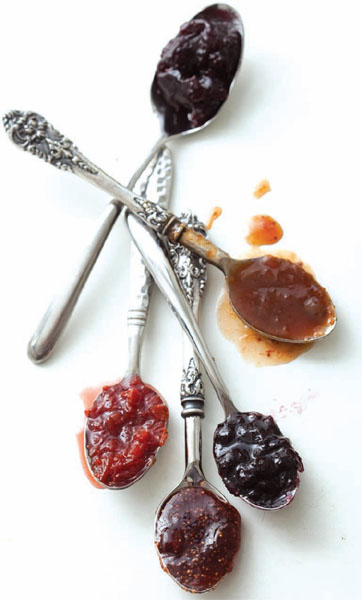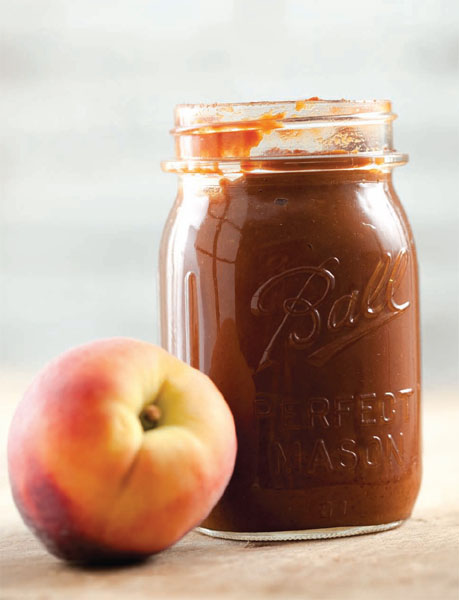Food in Jars (8 page)
Authors: Marisa McClellan

S
EVERAL YEARS AGO, I STARTED SEEING THE PEARGINGER
combination everywhere. Companies were using it to flavor granolas and several different brands made a sweetened sparkling water drink with a pear-ginger flavor base. I liked the idea of those two tastes together and so took a stab at making something that featured them. This jam was the happy result. I've taught a number of early-winter canning classes using this recipe as the starting point and it never fails to make people swoon. It's really good heaped atop a stack of whole grain pancakes or swirled into oatmeal.
8 cups cored and chopped Bartlett or Anjou pears (about 4 pounds/1.8 kg)
4 cups/800 g granulated sugar
1 cup/240 ml ginger juice (see instructions on
page 31
)
2 (3-ounce/85 ml) packets liquid pectin
Prepare a boiling water bath and 4 regular-mouth 1-pint/500 ml jars according to the process on page 10. Place the lids in a small saucepan, cover them with water, and simmer over very low heat.
In a large, nonreactive pot, combine the chopped pears, sugar, and ginger juice. Cook over medium heat until the fruit can easily be smashed with the back of a wooden spoon. Use a potato masher or immersion blender to break the fruit down into a mostly smooth sauce.
Add the liquid pectin and bring to a rolling boil. Let boil for a full 5 minutes.
Remove the pot from the heat and ladle the jam into the prepared jars. Wipe the rims, apply the lids and rings, and process in a boiling water bath for 10 minutes (see
page 11
).
Note:
As long as you choose a thin-skinned pear like a Bartlett or Anjou, there is no need to peel the pears for this recipe. I find that the skin just melts into the jam. However, with tougher skinned pears like Bosc, I would recommend peeling before cooking the fruit down into jam.

T
HIS IS A RECIPE I FIRST DEVISED AS A HOLIDAY
gift. It produces a preserve that is festively crimson and works just as well with a slice of cold turkey as it does spread on toast. This recipe also has a larger yield than many others in this book. When you're canning for holiday giving, I've found that it's always handy to have a couple extra jars. No matter how well I plan, I always find that there's a neighbor or co-worker I've inadvertently left off the list.
8 cups peeled, cored, and diced apples (about 4 pounds/1.8 kg apples; see
note
)
4 cups/400 g fresh cranberries
6 cups/1.2 kg granulated sugar
Zest and juice of 2 lemons
Prepare a boiling water bath and 5 regular-mouth 1-pint/500 ml jars according to the process on page 10. Place the lids in a small saucepan, cover them with water, and simmer over very low heat.
Combine the apples, cranberries, sugar, and 1 cup/240 ml water in a large pot (use a big one, as this jam will bubble). Bring to a boil over high heat, skimming off the foam that develops on the top of the fruit. Continue to boil for 15 to 20 minutes, until the cranberries pop and the apples soften.
Add the lemon zest and juice. Reduce the heat and simmer until the liquid in the pot has thickened, about 10 minutes. (Because both apples and cranberries are naturally high in pectin, you won't need any additional pectin to help this jam set, as long as you cook it until thick and syrupy).
Remove the pot from the heat and ladle the jam into the prepared jars. Wipe the rims, apply the lids and rings, and process in a boiling water bath for 10 minutes (see
page 11
).
Note:
When choosing apples for jam or butter, it's good to pick a softer fleshed apple such as Golden Delicious, Cortland, or Winesap. I like to use a couple different varieties in each batch to increase the depth of flavor.

A
FTER A BUSY SUMMER OF CANNING, I'M ALWAYS
grateful when late fall arrives and the preserving frenzy cools down. By January, I start to itch for a reason to pull out the canning pot and fill a few jars. This recipe fills the bill and is actually the perfect thing for storage apples that have seen better days. They may not be so good for eating fresh, but they cook into applesauce and then jam like a dream.
6 cups peeled, cored and chopped apples (about 3 pounds/1.4 kg apples; see note on
page 47
)
Zest and juice of 4 lemons
2½ cups/500 g granulated sugar
½ cup/120 ml honey
Prepare a boiling water bath and 4 regular-mouth 1-pint/500 ml jars according to the process on page 10. Place the lids in a small saucepan, cover them with water, and simmer over very low heat.
Combine the chopped apples and lemon juice in a large pot. Bring to the very barest of simmers over medium heat then reduce the heat to medium-low. Cook the apples down into a chunky sauce, stirring frequently, until they can easily be mashed with the back of a wooden spoon. This will take between 20 to 30 minutes, depending on the age of your apples. Once the apples are quite soft, smash them a bit more with a potato masher.
Add the sugar and honey. Increase the heat to medium-high and bring to a simmer. (At this point the jam will become quite splashy. Use a mesh splatter shield if you have one to keep the flying bits of jam off your arms and stovetop.)
After an additional 10 minutes of sputtering cooking, the jam should be thickening and quite sticky looking. Remove the pot from the heat and stir in the lemon zest. Ladle the jam into the prepared jars. Wipe the rims, apply the lids and rings, and process in a boiling water bath for 10 minutes (see
page 11
).

Clockwise from top: Nearly Seedless Blackberry Sage Jam, Rhubarb Jam with Strawberries and Oranges, Blueberry Jam, Strawberry Vanilla Jam, Apple Cranberry Jam


M
Y FIRST INTRODUCTION TO FRUIT BUTTERS
came through reading, not eating. During my early elementary school years, I was fascinated by those “When They Were Young” biographies about famous figures in history and read every one I could track down. It was in the book about fellow Philadelphian Betsy Ross that I discovered that butter could be something more than just the dairy product we spread on toast. The book described the young Betsy helping her mother by tending the huge pot of apple butter, as it slowly cooked down over an open fire. I wanted to do that, too.
A few years later, my family found ourselves living in a house in Portland, Oregon, that had a number of antique apple trees. Not wanting those apples to go to waste, my mom and I started making applesauce and later, apple butter. I got my wish.
These days, making fruit butters is a regular part of my year. I like them because they require less additional sweetener than jams and never need pectin. The trade-off you make when you cook up a batch of fruit butter is that your yield will always be smaller than with a batch of jam. But, as I am the only member of my household who likes these sweet spreads, this is actually a plus. Additionally, if you have a tree that produces a massive influx of fruit once a year, you'll also like this feature.
The other major difference between jams and fruit butters is that the butters get cooked low and slow for a good long time. I'm a big believer in using a slow cooker for fruit butters, because of its ability to produce low, even heat for extended periods of time. (Keep in mind that newer slow cookers cook hotter than the older ones. Because of this, the recipes that call for slow cookers offer a time range instead of a one-size-fits-all recommendation.)
You can also make fruit butters on the stovetop (when stove-topping it, I recommend one of those fine mesh splatter shields most commonly used for
frying) or even in the oven. In the following recipes, I will elaborate on each of these techniques. However, you should know that just because a recipe calls for the stovetop method doesn't mean that you are wedded to the stovetop for that particular ingredient for all time. As you get more comfortable with the making of fruit butters, you'll find the method that appeals to you most.
There's one last thing to know about fruit butters. Because they have less sugar in them, they don't have the same shelf life as jams. Sugar is a powerful preservative, so if a product has less of it, it won't be able to hold off the ravages of time as well. This doesn't mean you shouldn't make fruit butters, it's just important to remember that they should be eaten within six to eight months of going into the jar.
